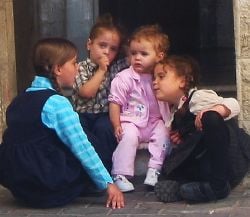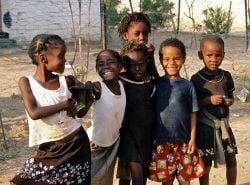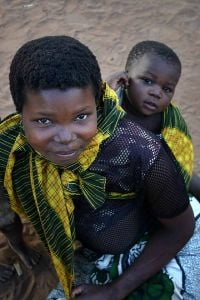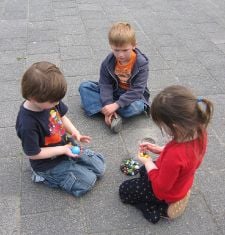
Childhood (being a child) is a broad term usually applied to the phase of Human development between infancy and adulthood. Childhood is the time during which human beings develop their physical bodies and their mental abilities. It is a crucial time, for if development goes wrong or growth does not occur within a critical time period the damage is often difficult to repair if not irreversible. Yet it is also a time of freedom from the responsibilities of adult life, a time in which parents, or other responsible adults, take care of the child, fulfilling his or her needs and keeping them safe.
Physical development is relatively straightforward—if the child receives adequate food, shelter, and exercise, and is protected from harm the body naturally grows to fulfill its physical potential. Psychological development is more complex. While experience and a good environment are essential, just as for physical growth, each individual still has free will to make decisions on whether to live a self-centered life or to learn to live for the sake of others. The role of parents and other caring adults, including both those within the family and those in the wider community such as teachers, is crucial in guiding the child to make good decisions.
However, not all children grow up in such a safe, and cared for environment. For many, childhood is not the best time of their life, but rather a time in which survival is the goal, not new experiences that nurture healthy development. When a child grows up under difficult situations, whether they are physically challenging such as poverty, famine, or war, so that physical needs are not met, or mentally, emotionally, and socially lacking, such that the child fails to develop healthy relationships with others or to develop cognitive skills, the resulting adult does not achieve their potential and they and society as a whole suffer. Children are the future of any society; for human society to be successful caring for the children is of the highest priority.
Definition
A child (plural: children) is a boy or girl who has not reached puberty, but also refers to offspring of any age. Adults remain the children of their parents, no matter what their age.
The United Nations Convention on the Rights of the Child (1989), often referred to as CRC or UNCRC, an international convention setting out the civil, political, economic, social, and cultural rights of children, defines a child as "every human being below the age of 18 years unless under the law applicable to the child, majority is attained earlier."
The legal definition of "child" is interchangeable with minor and may vary by country, in keeping with cultural conceptions.
Attitudes toward children

Social attitudes toward children differ around the world, and these attitudes have changed over time. Modern views regard childhood as a most significant time, with renowned psychologists, including Sigmund Freud, arguing that the "formative" years (until around five or seven years of age) determine a person's life course to a very great extent. Others, such as John B. Watson and John Bowlby argued, from different theoretical stances, that the early months of an infant's life were critical. Concurrent with these academic views has been greater societal awareness of children as in need of care, attention, and protection. This has been reflected in legislation mandating compulsory education, protection from exploitation through child labor, and against child abuse to name a few. But these developments are still recent; historically childhood was viewed differently.
In early times, children were viewed as property in many societies. The practice of infanticide, found in a number of cultures, took many forms, such as child sacrifice to supernatural figures or forces, as allegedly practiced in ancient Carthage. In some periods of Roman history, parents traditionally brought their newborn to the pater familias, the family patriarch, who would then decide whether the child was to be kept and raised or left to die by exposure. The Twelve Tables of Roman law obliged the pater familias to put to death a child with visible deformities. Female infants were especially vulnerable, as they were considered less valuable than boys who would be able to support the family whereas daughters would leave the family upon marriage, possibly even costing the family in the case of giving a dowry. Roman families often kept only one daughter (Breiner 1990). Although infanticide became a capital offense in Roman law in 374 C.E., offenders were rarely, if ever, prosecuted. Christianity from its earliest days, however, rejected the notion of infanticide. The Didache prescribed, "You shall not murder a child by abortion nor kill that which is born." As Christianity spread through Europe so did he condemnation of infanticide.
More than just condemning infanticide, Christianity taught concern for children. In place of infanticide or abortion of unwanted children, the Church took them into convents or monasteries to be raised to serve the church. Religious writings began to glorify the innocence and purity of childhood. Within the medieval period, though, childhood was short and those as young as seven were expected to participate in household and community work. Philippe Ariès (1965), a French medievalist and historian, proposed through his study of paintings, diaries, furniture, and school records that the conception of childhood as a distinct and important phase of life is a relatively modern one. Prior to the seventeenth century, children, once weaned and grown beyond infancy, were regarded as mini-adults. They were dressed as such, expected to participate in family activities, including work, along with the adults. His ideas led to the view that all past societies treated children badly (deMause [1974] 1995). Historians have since questioned and discredited Ariès' theory, however, noting that his findings reflect artistic style and skill more than beliefs and practices related to childhood. Still, the recognition of childhood as an extended time of development, both through learning and play, was not the norm in Western cultures until the twentieth century.
During the Renaissance, orphanages set up by charitable institutions began to emerge. This did not impact social attitude to children much, however, and children continued to be expected to work. The Protestant Reformation brought about a significant change in attitude to child-rearing. John Calvin, instead of regarding the child as innocent and pure, taught the doctrine of Original Sin and that even newborn infants are naturally inclined toward evil unless given the correct guidance and instruction (Pollock 1990). Thus, the Puritans took parenting very seriously, with manuals to aid parents and a focus on strict discipline and education.
The Victorian era has been described as a source of the modern institution of childhood. Ironically, the Industrial Revolution during this era led to an increase in child labor. Due to the campaigning of the Evangelicals, and efforts of authors such as Charles Dickens, child labor was gradually reduced and halted in England via the Factory Acts of 1802-1878. The Victorians concomitantly emphasized the role of the family and the sanctity of the child, and broadly speaking, this attitude has remained dominant in Western societies since then.
Not all early cultures treated children badly, despite deMause's horrifying claim that:
The history of childhood is a nightmare from which we have only just awoken. The further back in history one goes, the lower the level of child care, and the more likely children are to be killed, abandoned, beaten, terrorized, and sexually abused (deMause 1995)
In fact, this description is more similar to reports of late twentieth century child abuse in the United States than long ago practices of early cultures. Anthropological studies of so-called "primitive cultures," such as hunter-gatherers like the !Kung people who live in the Kalahari Desert, reveal a very different picture. !Kung parents have traditionally believed that children are psychologically immature, and need time to be infants and children. Babies are picked up whenever they cry. Children are not expected to do chores until adolescence, have no rules governing their daily life, and are rarely disciplined except for wasting food. Physical punishment is never used. The !Kung believe that the passage of time is both necessary and sufficient to eliminate undesirable behaviors (Konner 1991). Quite a different approach from the "spare the rod spoil the child" view of child-rearing adopted in Judeo-Christian cultures based on writings in the Book of Proverbs.
In Asia, by contrast, strict discipline is the norm (except for the very young), based on Confucianism which requires children to show respect or filial piety to their elders, particularly their father, at all times. While punishments for disrespect are not necessarily physical, children quickly learn to behave appropriately in keeping with society as a whole.
Despite cultural variations, children have been and are regarded by families and societies as valuable, albeit in some cases only potentially. The differences in attitude towards childhood are based more on failures of the "experts" to guide parents and society than they are negative attitudes held by the population as a whole. Benjamin Spock the famous American pediatrician whose book Baby and Child Care, published in 1946, was one of the biggest best-sellers of all time and influenced several generations of parents to be more flexible and affectionate with their children, and to treat them as individuals. He noted that the "so-called 'experts' have changed their advice over the decades" and that mothers "know more than you think you do" (Spock [1945] 2004). Ultimately, children are the future of any society, and indeed the world, and childhood is recognized as the time when the foundations for that future are laid.
Impact of modernization
While attitudes toward childhood have varied in different times and places, as might be expected given the differing circumstances, a number of clear changes occurred with modernization (Konner 1991):
- Mortality
The death rate—mortality—in children, infants, and mothers giving birth has declined dramatically with modernization. This has been attributed to improved medical knowledge and care, but is more significantly due to social and economic changes that prevent the spread of infectious diseases.
- Family size
With the reduction in child mortality, family size at first increased and then decreased. Parents today are more confident in the survival of their children to adulthood and, together with advances such as contraception which permit more effective family planning, are often satisfied with a smaller number of children to complete their family.
- Physical growth
Changes in nutrition and other factors have led to increase in the size and rate of growth of children, including earlier onset of puberty.
- Child labor and education
Child labor increased with the Industrial revolution, but then decreased as legislation was enacted to limit exploitation of children as workers and to improve their education. Adolescents are, however, expected to being working part-time while completing their education; all children, including those in early childhood, are expected to help with household chores to the extent that they are physically able.
Childhood today
Today, it is recognized throughout the world that the early years of a child's life are crucial for cognitive, social, and emotional development. Therefore, efforts are made to ensure that children develop in safe, loving, and secure environments. The United Nations Convention on the Rights of the Child (CRC) requires that states act in the best interests of the child. The CRC is an expansion upon the Declaration of the Rights of the Child endorsed by the League of Nations General Assembly on November 26, 1924. It states that: By the present declaration of the Rights of the Child, commonly known as the Declaration of Geneva, men and women of all nations, recognizing that mankind owes to the Child the best that it has to give, declare and accept it as their duty that beyond and above all considerations of race, nationality or creed:
- The child must be given the means requisite for its normal development, both materially and spiritually.
- The child that is hungry must be fed, the child that is sick must be nursed, the child that is backward must be helped, the delinquent child must be reclaimed, and the orphan and the waif must be sheltered and succoured.
- The child must be the first to receive relief in times of distress.
- The child must be put in a position to earn a livelihood, and must be protected against every form of exploitation.
- The child must be brought up in the consciousness that its talents must be devoted to the service of its fellow men.

On November 20, 1959 the General Assembly of the United Nations adopted a much expanded version as its own Declaration of the Rights of the Child. The CRC further expanded these points.
The CRC acknowledges that every child has certain basic rights, including the right to life, his or her own name and identity, to be raised by his or her parents within a family or cultural grouping, and have a relationship with both parents, even if they are separated.
The Convention obliges states to allow parents to exercise their parental responsibilities. The Convention also acknowledges that children have the right to express their opinions and to have those opinions heard and acted upon when appropriate, to be protected from abuse or exploitation, to have their privacy protected, and requires that their lives not be subject to excessive interference.
The Convention also obliges signatory states to provide separate legal representation for a child in any judicial dispute concerning their care and asks that the child's viewpoint be heard in such cases. The Convention forbids capital punishment for children.
This approach is different from that found in many countries that had previously treated children and wives as possessions or chattels, ownership of which was often argued over in family disputes. In many jurisdictions, properly implementing the Convention requires an overhaul of child custody and guardianship laws, or, at the very least, a creative approach within the existing laws.
In the West, generally, the twentieth century was a time in which the child became increasingly central in the family and society. As family size decreased children were given more space, more material possessions (toys, clothes, and so forth), and greater attention. Orphanages and foster care ensured that children would have a home; compulsory education and programs like Head Start ensured that basic skills would be acquired; juvenile courts guaranteed age appropriate treatment for young offenders, among other advances (Marten 2008).
However, to guarantee that an individual successfully passes through childhood and becomes an adult, who can fulfill their individual potential and contribute in meaningful ways to society, takes more than these forms of care. Even with all these advances children today are afflicted with drug abuse, alcoholism, unwanted pregnancy, depression, suicide, and criminal activities including school shootings in which tragic harm has been done to others as well as themselves.
Child development
Child development is the study of the processes and mechanisms that accompany the physical and psychological development of human beings as they mature from birth to adulthood. Since factors during pregnancy have been found to be significant in the development of an individual, the period from conception to birth is also included in this field of study.
Most of the physical and mental development of a person takes place in childhood. In terms of physical development, early childhood is the time in which significant physical growth occurs, growth which depends on adequate nutrition and healthy physical exercise and environment. It is the critical period for establishing good habits of both exercise and nutrition which can last a lifetime. By the age of seven, nearly all the motor control mechanisms in the brain are present and the child is rapidly developing motor skills. In preadolescence there are major growth spurts (usually experienced by girls between the ages of 9 and 12 years, and by boys between 11 and 14 years). Muscles, tendons, and bones require adequate nutrition and reasonable exercise to develop well. Puberty involves significant physical developments including the development of sexual organs and secondary sexual characteristics, which clearly differentiate boys from girls. Onset of puberty is affected by a number of factors: genetic, physical, and psychological (Lansdown and Walker 1991).
Psychological development is even more complex. In fact psychologists, since the beginning of psychology as an academic discipline, have debated the relative impact of inherited ("nature") characteristics versus the environment ("nurture") on a child's mental growth. Early theorists put almost total emphasis on one or the other, Behaviorists following John Locke's environmentalist position that all knowledge is acquired through experience and learning, while those like Arnold Gesell proposed that all development occurs naturally through maturation following Jean-Jacques Rousseau's Nativist conception of innate processes of development. Today it is generally accepted that what an individual inherits and how they are treated are both of crucial importance. Development is a process involving an interaction between children and their world (Lansdown and Walker 1991). The inherited component takes the form of an individual temperament and potential abilities, which can be nurtured or constrained by experiences. Thus, children have innate differences that range from physical characteristics, gender, personality types, cognitive abilities, to creativity, all of which taken together with their experiences leads them to grow up as unique human beings.
The essence of psychological development, regardless of which theoretical position is espoused, is that the individual grows from the dependence of infancy to the maturity of adulthood. This is a process that requires interaction with the environment, both physical and social. Such interactions are two-way—with the child affecting as well as being affected by his or her environment (Lansdown and Walker 1991). The process begins in the womb, as the mother's activities affect the experiences of the fetus and likewise the activities of the fetus, kicking and turning, make the mother aware of a living presence. Immediately following birth, the newborn begins to interact with the environment, finding food, warmth, shelter, and the companionship of other human beings, in particular that of the mother whose voice and heartbeat are already familiar.
Attachment theory, developed by John Bowlby, suggests that children form "inner working models" for all future relationships from the interactions they have with their first caretakers—usually their mothers. Empathy is learned from following and imitating the expressions and levels of emotions expressed by mothers as they play with their child, soothe their child, and respond to the infant's needs. The first developmental "crisis" of trust versus mistrust, as Erik Erikson put it, is resolved positively by a parent's caring responses to her child. This crisis can also have a negative outcome—leading to a lifetime of mistrust—when parents fail to care adequately for their child (Erikson 1993). As the child grows, he or she internalizes the values of familiar adults, particularly parents. Out of love for them and desire for their approval, the child learns obedience, self-control, cleanliness, diligence in doing schoolwork, and respectful behavior towards people and property. Children who are neglected or abandoned by their parents and lack consistent loving caregivers fail to develop emotionally or to establish trust, they are often "unable in later years to bind themselves to other people, to love deeply" (Fraiberg 1996).
Stages of childhood
Another significant issue in child development is Ernst Haeckel's idea of "recapitulation"—ontogeny repeats phylogeny—that the embryonal development of an individual organism (its ontogeny) follows the same path as the evolutionary history of its species (its phylogeny). This relates to the idea of stages of development, where development is seen as a discontinuous process involving distinct stages characterized by qualitative differences in behavior. Stage theories can be contrasted with continuous theories, which posit that development is a incremental process of growth (Vasta et al 1998). Again, regardless of the theoretical explanation, it is clear that children pass through a number of time periods in which different types of growth occur.
The following list reflects the division of ages of child development commonly found in the twenty-first century. However, these age ranges are approximate, and may differ from culture to culture.
- Fetus
There has been much debate on the question of when life begins. Some have argued that human life begins at conception, when the zygote is formed through fertilization, becoming an embryo. For others, the view is that a fetus takes on the status of a human being when it can survive outside the womb. A third view is that human life proper begins at birth, when the child breathes a first breath.
Undeniably, however, the physical beginnings of life take place at conception, as the DNA of the parents is present in the first cell of the child—the zygote. The physical development of the fetus depends on the environment within the mother, in her womb, and the nutrients supplied by the mother's body. These, and the DNA, are the building blocks of the child's physical body. Thus, from this physical standpoint, conception is the moment when childhood begins, and the preparation for this moment has already taken place in the lives of the parents.
Psychologically, it is also the case that the child begins to exist prior to birth. The mother is very aware of the presence of life inside her, and at some point recognizes that her body is hosting a new, living individual being that is not under her control.
- Newborn
Newborns, or neonates, in the first month outside of the womb have their first experiences of life in the "real world." These experiences are necessarily limited due to immaturity of the physical body, yet they are substantial and essential for their growth, if not survival. The learning process begins immediately as the baby seeks and sucks on the mother's breast for nourishment, turns to look when hearing a sound, and respond to touch and other sensations. Surprisingly, an infant as young as only twelve hours can begin to imitate movements and expressions on the faces of adults who interact with them (Lansdown and Walker 1991).
- Infancy
The first year and a half of the child's life is known as infancy, and it is during this period that changes occur with the greatest rapidity. Physical growth occurs most rapidly both in size and proportion in this period (Lansdown and Walker 1991). Motor skills also develop, from watching hand movements to learning to walk.
- Toddlerhood
Once the child has started walking, albeit imperfectly, they enter toddlerhood, a period that lasts until approximately three to four years of age. This is a time when physical growth continues to be significant, and at around age two and a half children attain half their adult height. Psychological development is also significant, as the toddler is now independently mobile and able and excited to explore the environment. With such increased interaction comes cognitive development—language appears and becomes increasingly developed in this period, simple reasoning and classification abilities develop, and so forth. The toddler becomes increasingly social, moving from individual play or "parallel play" (individuals playing in the same location but without interaction) to being able to play together in small groups. For many, some form of preschool education is a significant social change, as they spend significant time in the company of peers and away from their parents.
- Early childhood
From approximately four to seven years, children in this early childhood grow from chubby toddlers into slimmer children with stronger muscles, harder bones, and more developed brains, allowing them to begin a whole new set of achievements. From the age of three to seven a child's thinking develops: perception is more acute, attention, memory, and reasoning all expand. Through these changes, the child's creativity blossoms and learning is rapid and multifaceted—the child appears "like a sponge" soaking up information. In this period, if they have not already experienced a preschool setting, it is common for them to leave the intimate family setting and enter an early educational setting, such as kindergarten or elementary school.
- Middle childhood
Middle childhood, or the ages from approximately seven to puberty, are years of slower and less spectacular physical growth. Physical abilities are enhanced as further brain development and practice support more accurate motor skills. Variations in personality or culture lead to marked differences among children at this time, some spending their time in physical pursuits such as sports while others prefer to develop fine motor skills, such as drawing and writing. Differences in gender do become more apparent in this age group, with boys tending to be more active and girls more content with less physical and more social activities. However, this is only a generalization; boys and girls continue to enjoy playing together, finding interests and abilities in common more through individual personality than according to gender.
- Adolescence
In adolescence, or the teenage years, gender differences predominate. Physical differences, including the onset of menarche for girls as well as obvious physical changes in both at puberty, are more pronounced and undeniable. Socially, too, boys and girls become aware of their future roles as men and women in relation to each other. The changes of adolescence include all aspects of psychological life: emotion, cognition, social relationships, moral development, and so forth. When the child emerges from adolescence he or she is an adult, expected to enter society as a fully functioning member with both rights and responsibilities.
Rites of passage
There are a number of rites of passage that take place in most societies, both historically and today, that mark an individual's growth to maturity. Just as the stages of childhood begin with conception, so do these significant social markers.
- Pregnancy and birth
When the mother announces her pregnancy, particularly if it is her first, celebrations are common, including a baby shower which provides many of the items new parents need to take care of their child. Further celebrations accompany the birth. Historically, though, many societies reserved their celebrations until a period of time after the birth, so as to ensure that the new child had survived.
- Circumcision
Male circumcision is the removal of some or all of the foreskin from the penis. The time of circumcision differs from culture to culture: either shortly after birth, during childhood, or around puberty as part of a rite of passage. As a religious practice it is most prevalent in the Jewish and Muslim faiths. Others practice it for health reasons.
- Infant baptism
Infant baptism is the Christian religious practice of baptizing infants or young children as a mark of entering the faith and thus being able to receive the grace consequent upon this. Most Christian churches practice infant baptism, including the Roman Catholic Church, the Eastern Orthodox Church, Oriental Orthodoxy, the Anglican Communion, Lutherans, Presbyterians, and Methodists, although a number of Protestant denominations do not. Generally, infant baptism involves the minister either pouring water (affusion) or sprinkling water (aspersion) on the child.
- Education
Many rites of passage center around a child's education. The first day of school is an especially important rite of passage in Western culture. The completion of education, marked by a graduation ceremony, is acknowledged in most cultures as a rite of passage.
- Coming of age

Coming of age rituals, which occur in different forms in most cultures, are some of the most recognized rites of passage. For example, debutante balls, which are traditionally held in upper class Western society, and quinceañeras (literally 15 years), which take place in Hispanic communities, mark a girl's introduction into womanhood. Birthday celebrations often serve as rites of passage, such as "sweet sixteen" parties in the United States.
In Judaism, according to Jewish law, when Jewish children reach the age of maturity (12 years for girls, 13 years for boys) they become responsible for their actions. A special ceremony Bar Mitzvah (Hebrew: בר מצוה), or Bat Mitzvah for girls, marks the age at which they become Bar Mitzvah literally meaning "one to whom the commandments apply"). Before this age, the responsibility of the child to follow Jewish law and tradition lies with the parents. After this age, the children are privileged to participate in all areas of Jewish community life and bear their own responsibility for Jewish ritual law, tradition, and ethics.
The Poy Sang Long is a ceremony undergone by boys in Burma and Thailand where they become novice monks and temporarily live the monastic lifestyle. Coming of age rituals can involve scarification and various other physical endurances, sometimes combined with spiritual experiences such as in the vision quest of many Native Americans.
- Marriage
The end of childhood, marked symbolically by coming of age rituals, is concluded in actuality by marriage. For, through marriage, an individual is no longer only the child of their parents but has begun to establish their own family, in which they become parents to their own children, continuing the cycle of life.
ReferencesISBN links support NWE through referral fees
- Ariès, Philippe. 1965.Centuries of Childhood: A Social History of Family Life. New York, NY: Vintage. ISBN 978-0394702865
- Boas, George. [1966] 1990. The Cult of Childhood. Spring Publications. ISBN 978-0882142180
- Breiner, Sander J. 1990. Slaughter of the Innocents: Child Abuse Through the Ages and Today. Plenum Publishing Corporation. ISBN 0306434598
- Brown, Marilyn R. (ed.). 2002. Picturing Children: Constructions of Childhood between Rousseau and Freud. Aldershot: Ashgate. ISBN 978-0754602774
- Buckingham, David. After the Death of Childhood: Growing Up in the Age of Electronic Media. Blackwell Publishers. ISBN 0745619339.
- Bunge, Marcia J. (ed.). 2001. The Child in Christian Thought. Grand Rapids, MI: William B. Eerdmans Publishing Co. ISBN 978-0802846938
- Calvert, Karin. 1994. Children in the House: The Material Culture of Early Childhood, 1600-1900. Boston, MA: Northeastern University Press. ISBN 978-1555531898
- Cleverley, John, and D.C. Phillips. 1986. Visions of Childhood: Influential Models from Locke to Spock. New York, NY: Teachers College. ISBN 978-0807728000
- Cunningham, Hugh. 2005. Children and Childhood in Western Society since 1500. London: Longman. ISBN 978-0582784536
- Cunnington, Phillis, and Anne Buck. 1965. Children’s Costume in England: 1300 to 1900. Adam & Charles Black.
- deMause, Lloyde, ed. [1974] 1995. The History of Childhood. London: Jason Aronson. ISBN 978-1568215518
- Erikson, Erik. 1993. Childhood and Society. W.W. Norton. ISBN 039331068X
- Fraiberg, Selma H. 1996. The Magic Years. Simon & Schuster. ISBN 0684825503
- Higonnet, Anne. 1998. Pictures of Innocence: The History and Crisis of Ideal Childhood. London: Thomas and Hudson Ltd. ISBN 978-0500280485
- Immel, Andrea, and Michael Witmore (eds.). 2005. Childhood and Children’s Books in Early Modern Europe, 1550-1800. New York, NY: Routledge. ISBN 978-0415972581
- Kagan, Jerome. 1984. The Nature of the Child. New York, NY: Basic Books. ISBN 046504851X
- Kincaid, James R. 1994. Child-Loving: The Erotic Child and Victorian Culture. New York, NY: Routledge. ISBN 978-0415910033
- Konner, Melvin. 1991. Childhood. Boston, MA: Little, Brown & Company. ISBN 0316501840
- Landsdown, Richard, and Marjorie Walker. 1991. Your Child's Development from Birth through Adolescence. New York, NY: Alfred A. Knopf. ISBN 0394578147
- Müller, Anja (ed.). 2006. Fashioning Childhood in the Eighteenth Century: Age and Identity. Burlington, VT: Ashgate. ISBN 978-0754655091
- O’Malley, Andrew. 2003. The Making of the Modern Child: Children’s Literature and Childhood in the Late Eighteenth Century. London: Routledge. ISBN 978-0415942997
- Office of the High Commissioner for Human Rights. 1959. Declaration of the Rights of the Child. United Nations General Assembly resolution 1386 (XIV) of 20 November 1959. Retrieved February 22, 2021.
- Office of the High Commissioner for Human Rights. 2002. Convention on the Rights of the Child United Nations General Assembly resolution 44/25 of 20 November 1989. Retrieved February 22, 2021.
- Pollock, Linda A. 1984. Forgotten Children: Parent-child relations from 1500 to 1900. Cambridge: Cambridge University Press. ISBN 978-0521271332
- Pollock, Linda A. 1990. A Lasting Relationship: Parents and Children Over Three Centuries. Lebanon, NH: University Press of New England. ISBN 0874515076
- Shorter, Edward. 1977. The Making of the Modern Family. Basic Books. ISBN 978-0465097227
- Sommerville, C. John. 1992. The Discovery of Childhood in Puritan England. Athens, GA: University of Georgia Press. ISBN 978-0820313535
- Spock, Benjamin. [1945] 2004. Baby and Child Care. New York, NY: Pocket Books. ISBN 978-0743476676
- Steinberg, Shirley R., and Joe L. Kincheloe. 2004. Kinderculture: The Corporate Construction of Childhood. Westview Press Inc. ISBN 978-0813391540
- Stone, Lawrence. 1983. The Family, Sex and Marriage in England 1500-1800. New York, NY: Harper and Row. ISBN 978-0061319792
- Vasta, Ross, Marshall M. Haith, and Scott A. Miller. 1998. Child Psychology: The Modern Science, Third Edition. New York, NY: John Wiley. ISBN 047119221X
- Zornado, Joseph L. 2006. Inventing the Child: Culture, Ideology, and the Story of Childhood. New York, NY: Routledge. ISBN 978-0415979665
Credits
New World Encyclopedia writers and editors rewrote and completed the Wikipedia article in accordance with New World Encyclopedia standards. This article abides by terms of the Creative Commons CC-by-sa 3.0 License (CC-by-sa), which may be used and disseminated with proper attribution. Credit is due under the terms of this license that can reference both the New World Encyclopedia contributors and the selfless volunteer contributors of the Wikimedia Foundation. To cite this article click here for a list of acceptable citing formats.The history of earlier contributions by wikipedians is accessible to researchers here:
The history of this article since it was imported to New World Encyclopedia:
Note: Some restrictions may apply to use of individual images which are separately licensed.


